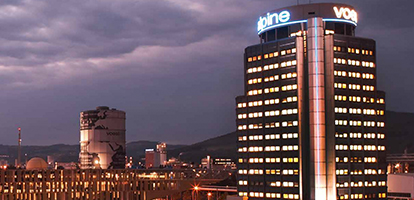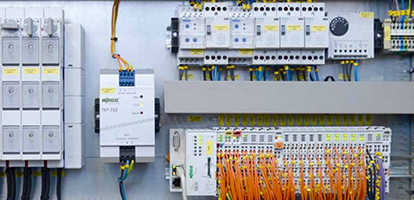


When updating the lighting system at a central warehouse in Linz, voestalpine, the Austrian technology and capital goods group, switched to DALI-capable LED lights in combination with the proven WAGO Lighting Management. To great success: based on the cost savings and the positive feedback on the part of the workforce, additional usage areas for the WAGO solution are under consideration.
The illumination of warehouses and production facilities often provide a great challenge for manufacturers: the costs should be low, yet the lighting quality needs to be high in order to create optimal light ratios for the employees. If the economic aspects are foregrounded with regard to lighting, then energy efficient illumination must be considered in combination with an intelligent lighting management system.
Even voestalpine has been engaged with this topic for several years. The lighting control in the production facilities and warehouses has been carried out up until recently using complex programs, which were generated for each building by external automation specialists, and depend on the specific demands for that site. The problem: the use of different programming languages that cannot communicate has resulted in a situation in which the centralized networking and control of the lighting system are impossible In addition, each new change in parameters requires knowledge of the programming language used. As the corresponding expertise is not always available to the necessary degree, the company depends on external service providers for more complex adjustments of the lighting technology.
Pre-Programmed Web Solution Selected
In the past year, the company went a step farther and turned to a pre-programmed Web solution for their lights: WAGO Lighting Management. Over the course of the lighting replacement in a central warehouse for steel rolls, which each weigh several tones, the company chose to use automated lighting control in combination with the LED technology. Since then, the building in Linz, which covers 5400 m², has been illuminated by around 60 DALI-capable LED lighting units controlled by the WAGO Lighting Management.
The challenges in this lighting management system are relatively straight forward for the initial step: a common, constant light control of all LED DALI lights with the aid of a brightness sensor in order to guarantee constant light levels at minimal energy consumption for all shifts. The artificial light should automatically adjust to natural light to optimally illuminate the building during every working hour, day or night. In addition, the individual operating modes, like “off,” “manual,” and “automatic” can be selected using a key-operated switch.
Start Up Before Lunch
The definition of all participants associated with the lighting management was carried out prior to start up. The individual DALI lights and the DALI light sensors were read into the system using the implemented scanning and addressing functions. The conventional digital inputs for the key-operated switch were automatically recognized, as they were part of the internal bus system. In the next step, the virtual rooms stored in the software were named according to their respective building components.
All previously defined participants, like key-operated switches, electronic DALI ballasts, and DALI sensors were allocated to the virtual rooms and assigned to the function “constant lighting regulation”. Subsequently, other diverse parameters were defined, for example, monitoring parameters, and adjusted to the specific application. The entire commissioning, including the function test, was carried out in a single morning.
Simple Maintenance, Easier Parameterizing
“After only a few months, it could be demonstrated that by adjusting the electric light to daylight and the use of the LED lights, the energy costs were already reduced. This was the case, even though the warehouse lighting level was actually increased,” reports Michael Haudum, who manages the project for voestalpine. In addition, maintenance on the new system is much easier. Haudum adds, “We can now carry out new parameterizations in house without any additional programming expense or need to call in third parties.” The WAGO Lighting Management enables the voestalpine maintenance department to monitor all parameters using a modern, standardized Web visualization, and to adjust them at any time as needed. New parameters can be recorded quickly and easily with the click of a mouse, even during operations. The graphic user interface can be called up by any standard browser in the internal voestalpine network. The system’s foundation is based on the popular web language HTML5, so local software installation on a PC is unnecessary.
“Based on the successful implementation in our warehouse, we are planning to introduce the WAGO solution in other areas in the future,” according to Haudum. This shows the high level of flexibility that can be achieved using WAGO Lighting Management: from a small facility with only one virtual room up to multiple networked distributors with 160 virtual rooms, including links to the building technology, everything can be centrally controlled and automated according to individual specifications. Haudum is also considering expanding the control functions in the application – for example, a colored lighting control for control stations. “Basically, we see the standardized web interface in the centralized, simple controller, and the essential advantages of the WAGO Lighting Management appear in the energy cost savings,” according to Haudum.
Text: Martin Morpurgo and Michael Gerner, WAGO
Photo: VOESTALPINE